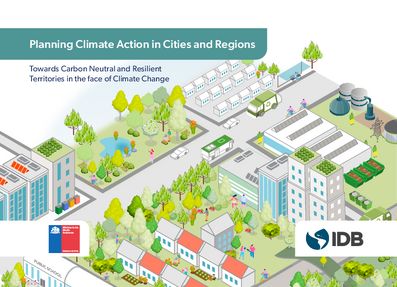Planning Climate Action in Cities and Regions: Towards Carbon Neutral and Resilient Territories in the face of Climate Change
Date issued
Sep 2023
Subject
Finance;
Municipal Government;
Climate Change;
Carbon Offsetting;
Ministries;
Climate Change Adaptation;
Water and Sanitation;
Climate Change Mitigation;
Forest Fire;
Energy;
Environment and Natural Resource;
Climate Finance;
Mode of Transport;
Flood Damage
JEL code
Q54 - Climate • Natural Disasters and Their Management • Global Warming;
R58 - Regional Development Planning and Policy;
Q58 - Government Policy
Country
Chile
Category
Monographs
The impacts of climate change are already being felt by our communities. Rising temperatures and extreme weather events not only affect the environment, they also affect our daily lives and how society functions. These impacts are evident in all regions of the world, and Chile, in particular, is highly vulnerable.
Faced with this urgency, in June 2022 Chile adopted the Climate Change Framework Law, which established goals for achieving carbon neutrality and resiliency by 2050 at the latest. In addition, it compels municipalities and regional governments to prepare climate change action plans.
In this context, this guide seeks to empower regional and municipal leaders to act decisively in the fight against climate change, promote coordination across different levels of government, and identify the transformations needed for a carbon neutral and resilient future and the climate actions required to implement these changes, overcome barriers, and inspire communities. This document was developed based on workshops with key stakeholders at the national, regional, and municipal levels, in addition to a literature review and context analysis of the experiences in the region.
The guide identifies the transformations required to increase resiliency and proposes actions to address climate challenges, such as heat waves, droughts, forest fires, and inland and coastal flooding, that threaten our communities. It also proposes transformations and actions to reduce greenhouse gas emissions from the energy, buildings, transportation, forest and nature, food and agriculture, and waste sectors. Examples of climate actions suggested in this guide include planting native tree species in urban areas, reusing greywater, installing low-emission air conditioners for cooling and heating, developing exclusive bus lanes, restoring forests and wetlands, and establishing recycling collection centers.
To support this climate action, the guide also identifies the keys to successful implementation, proposing a roadmap and providing a set of cross-cutting tools, such as possible financing options, administrative instruments, and an analysis of the legal competencies of municipal and regional governments. Finally, recommendations to promote climate actions are provided, which can be incorporated into municipal and regional climate change action plans.
Faced with this urgency, in June 2022 Chile adopted the Climate Change Framework Law, which established goals for achieving carbon neutrality and resiliency by 2050 at the latest. In addition, it compels municipalities and regional governments to prepare climate change action plans.
In this context, this guide seeks to empower regional and municipal leaders to act decisively in the fight against climate change, promote coordination across different levels of government, and identify the transformations needed for a carbon neutral and resilient future and the climate actions required to implement these changes, overcome barriers, and inspire communities. This document was developed based on workshops with key stakeholders at the national, regional, and municipal levels, in addition to a literature review and context analysis of the experiences in the region.
The guide identifies the transformations required to increase resiliency and proposes actions to address climate challenges, such as heat waves, droughts, forest fires, and inland and coastal flooding, that threaten our communities. It also proposes transformations and actions to reduce greenhouse gas emissions from the energy, buildings, transportation, forest and nature, food and agriculture, and waste sectors. Examples of climate actions suggested in this guide include planting native tree species in urban areas, reusing greywater, installing low-emission air conditioners for cooling and heating, developing exclusive bus lanes, restoring forests and wetlands, and establishing recycling collection centers.
To support this climate action, the guide also identifies the keys to successful implementation, proposing a roadmap and providing a set of cross-cutting tools, such as possible financing options, administrative instruments, and an analysis of the legal competencies of municipal and regional governments. Finally, recommendations to promote climate actions are provided, which can be incorporated into municipal and regional climate change action plans.
Generative AI enabled




